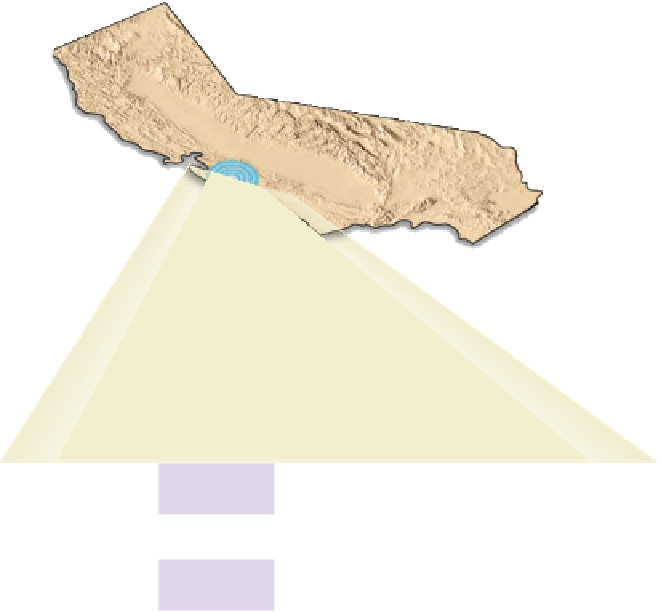Geology Reference
In-Depth Information
Reliable earthquake prediction is
still in the future, but can anything
be done to control or at least partly
control earthquakes? Because of
the tremendous energy involved,
it seems unlikely that humans will
ever be able to prevent earthquakes.
However, it may be possible to grad-
ually release the energy stored in
rocks, thus decreasing the probabil-
ity of a large earthquake and exten-
sive damage.
During the early- to mid-1960s,
Denver, Colorado, experienced
numerous small earthquakes. This
was surprising because Denver had
not been prone to earthquakes in
the past. In 1962, geologist David
M. Evans suggested that Denver's
earthquakes were directly related to
the injection of contaminated waste-
water into a disposal well 3674 m
deep at the Rocky Mountain Arsenal,
northeast of Denver (
Epicenter of
Loma Prieta
earthquake
San Francisco
fa
ult
San Juan
Bautista
Parkfield
Los Angeles
Southern
Santa Cruz
Mountains gap
San Francisco
Peninsula gap
Parkfield
gap
0
5
10
0
100
200
300
400
0
5
10
Figure 8.20a).
The U.S. Army initially denied that a
connection existed, but a USGS study
concluded that the pumping of waste
fl uids into fractured rocks beneath the
disposal well decreased the friction
on opposite sides of fractures and, in
effect, lubricated them so that move-
ment occurred, causing the earth-
quakes that Denver experienced.
Figure 8.20b shows the relation-
ship between the average number of earthquakes in Denver
per month and the average amount of contaminated fl uids
injected into the disposal well per month. Obviously, a high
degree of correlation between the two exists, and the corre-
lation is particularly convincing considering that during the
time when no waste fl uids were injected, earthquake activity
decreased dramatically.
Experiments conducted in 1969 at an abandoned oil
field near Rangely, Colorado, confirmed the arsenal hy-
pothesis. Water was pumped into and out of abandoned oil
wells, the pore-water pressure in these wells was measured,
and seismographs were installed in the area to measure any
seismic activity. Monitoring showed that small earthquakes
were occurring in the area when fl uids were injected and that
earthquake activity declined when fl uids were pumped out.
What the geologists were doing was starting and stopping
earthquakes at will, and the relationship between pore-water
pressures and earthquakes was established.
Based on these results, some geologists have proposed
that fluids be pumped into the locked segments or seis-
mic gaps of active faults to cause small- to moderate-sized
◗
0
100
200
300
400
Distance (km)
◗
Figure 8.19
Earthquake Precursors Seismic gaps are one type of earthquake precursor that
can indicate a potential earthquake in the future. Seismic gaps are regions along a fault that
are locked; that is, they are not moving and releasing energy. Three seismic gaps are evident in
this cross section along the San Andreas fault from north of San Francisco to south of Parkfi eld.
The fi rst is between San Francisco and Portola Valley, the second near Loma Prieta Mountain,
and the third is southeast of Parkfi eld. The top section shows the epicenters of earthquakes
between January 1969 and July 1989. The bottom section shows the southern Santa Cruz
Mountains gap after it was fi lled by the October 17, 1989, Loma Prieta earthquake (open circle)
and its aftershocks.
Their earthquake prediction program was initiated soon after
two large earthquakes occurred at Xingtai (300 km southwest
of Beijing) in 1966. This program includes extensive study
and monitoring of all possible earthquake precursors. In ad-
dition, the Chinese emphasize changes in phenomena that
can be observed and heard without the use of sophisticated
instruments, such as observing changes in animal behavior
or changes in well water levels. They successfully predicted
the 1975 Haicheng earthquake, but failed to predict the
devastating 1976 Tangshan earthquake that killed at least
242,000 people.
Progress is being made toward dependable, accurate
earthquake predictions, and studies are underway to assess
public reactions to long-, medium-, and short-term earth-
quake warnings. However, unless short-term warnings are
actually followed by an earthquake, most people will proba-
bly ignore the warnings as they frequently do now for hurri-
canes, tornadoes, and tsunami. Perhaps the best we can hope
for is that people in seismically active areas will take mea-
sures to minimize their risk from the next major earthquake
(Table 8.5).





































































Search WWH ::

Custom Search